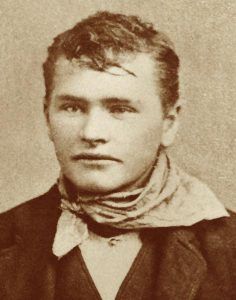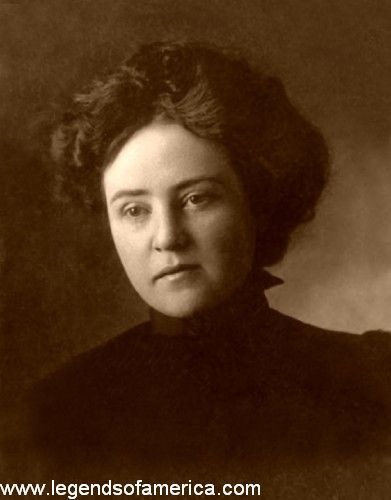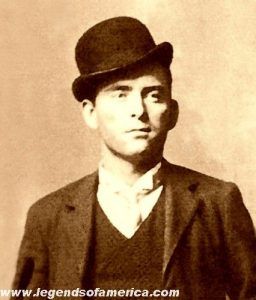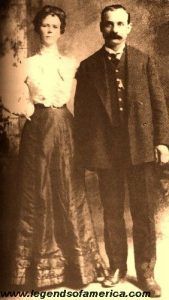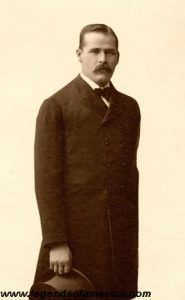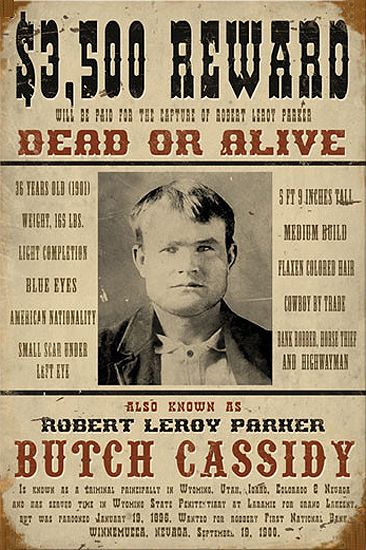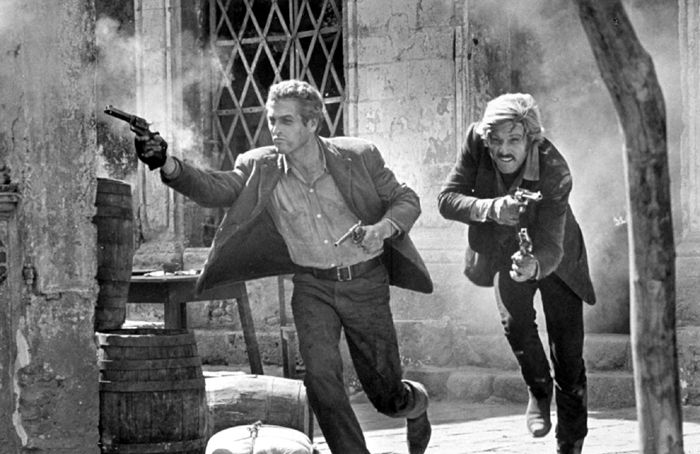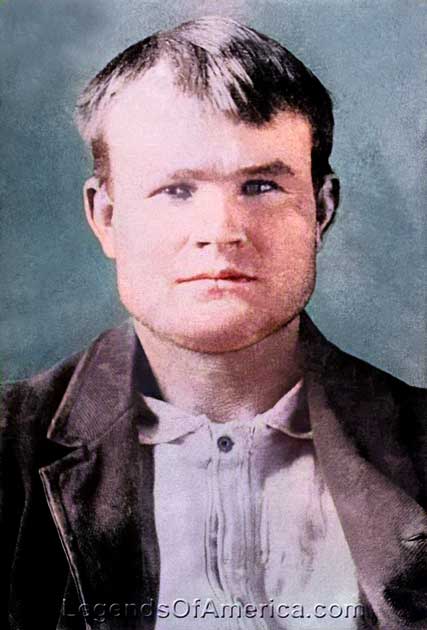
Butch Cassidy, 1894 mug shot at Wyoming Territorial Prison. Touch of color LOA.
Robert Leroy Parker, better known as Butch Cassidy, was a train and bank robber who led the Wild Bunch gang of outlaws who operated throughout Utah, Nevada, Wyoming, Colorado, and New Mexico.
Robert Leroy Parker was born on April 13, 1866, in Beaver, Utah, the first of 13 children of British immigrants Maximillian Parker and Ann Campbell Gillies. The Parker and Gillies families had converted to the Mormon faith while still living in England and Ireland before immigrating to America.
In 1879, the Parker family moved to a piece of property near Circleville, Utah, where they farmed and raised cattle. Robert left home during his early teens and went to work on a dairy farm, where he formed a close relationship with a cowboy and known cattle rustler who called himself Mike Cassidy (an alias for John Tolliver “J. T.” McClammy). Later, Parker worked on several ranches and was briefly employed by a butcher in Rock Springs, Wyoming, where he acquired the nickname “Butch.” Later, he borrowed his friend’s last name and began to go by the name of Butch Cassidy.
Butch continued to work on area ranches until he turned 18 in 1884. He then moved to Telluride, Colorado, telling his family that he would seek work in the town’s silver mines. However, he didn’t mention that he would be driving a herd of stolen horses down to Colorado. There, he took a few honest jobs while continuing to rustle horses. He also met Matt Warner, the racehorse owner, and Cassidy was soon immersed in the horse race scene.
Cassidy’s first bank robbery occurred on June 24, 1889, when he, Matt Warner, and the McCarty brothers — Tom and Bill, robbed the San Miguel Valley Bank in Telluride, Colorado stealing approximately $21,000. Fleeing into the rough country, they lost their trackers in a wilderness of canyons, hidden valleys, and high peaks known as Robber’s Roost.
In 1890, with his share of the loot stolen in Colorado, Cassidy purchased a ranch on the outskirts of Dubois, Wyoming, where he was known to have rustled cattle and horses. This location is across the state from the notorious Hole-in-the-Wall, a natural geological formation and a popular hideout for outlaw gangs, including Cassidy’s. Some historians surmise that the ranch was never economically successful but was a facade for clandestine activities.
In early 1894, Cassidy became involved romantically with outlaw and rancher Ann Bassett. Bassett’s father, rancher Herb Bassett, did business with Cassidy, supplying him with fresh horses and beef. That same year, Cassidy was arrested at Lander, Wyoming, for stealing horses. He was sentenced to two years in the Wyoming State Prison in Laramie but was released after 18 months.
Upon his full release in 1896, Cassidy resumed his life as a criminal. With several other well-known outlaws, including his best friend, William Ellsworth “Elzy” Lay, Harry “Sundance Kid” Longabaugh, Ben “Tall Texan” Kilpatrick, and Harvey “Kid Curry” Logan, they formed the nucleus of the group known as the “Wild Bunch,” Cassidy embarked on what is considered the longest stretch of successful train and bank robberies in American history. Others in the group included Harry Tracy, William “News” Carver, Laura Bullion, and George “Flat Nose” Curry. The group took its name from the Doolin–Dalton gang, also known as the “Wild Bunch.”
Robberies:
Their first robbery occurred on August 13, 1896, when Cassidy, Lay, Logan, and a man named Bob Meeks robbed the bank at Montpelier, Idaho, escaping with approximately $7,000. Numerous robberies would follow it in South Dakota, New Mexico, Nevada, Utah, Wyoming, and Montana. Between their robberies, the men hid at the Hole-in-the-Wall Pass, located in Johnson County, Wyoming, where several outlaw gangs had their hideouts. Shortly after this robbery, Cassidy recruited the Sundance Kid into the Wild Bunch.
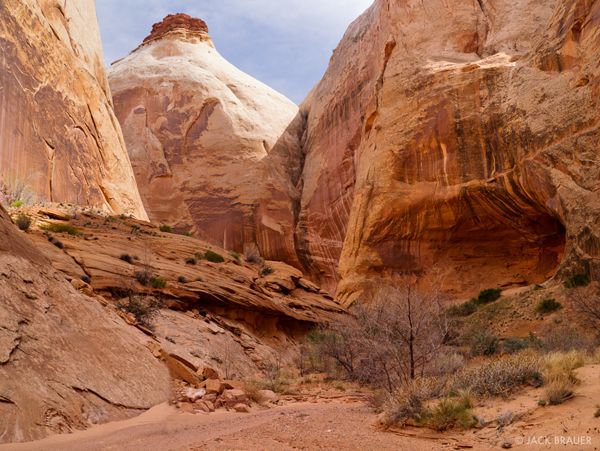
Robbers Roost, Utah, courtesy of Mountain Photography
In early 1897, Cassidy was joined at Robbers Roost by Ann Bassett and Elzy Lay’s girlfriend, Maude Davis. The four hid there until early April when Lay and Cassidy sent the women home so the men could plan their next robbery. On April 22, 1897, the pair ambushed a small group of men carrying the payroll of the Pleasant Valley Coal Company in Castle Gate, Utah. Making off with some $7,000 in gold before fleeing to Robbers Roost. The outlaw loot was never recovered, and many believe it was hidden by the gang somewhere near Robbers Roost, located along the Outlaw Trail in southeastern Utah. (See story HERE)
On June 28, 1897, six bandits, including Kid Curry, George “Flat Nose” Curry, Sundance Kid, Tom “Peep” O’Day, Harvey Logan, and Walt Punteney, robbed the bank at Belle Fourche, South Dakota. This robbery was not well-planned, as the gang got away with only $97, and Tom O’Day was caught hiding in a saloon privy. He was later tried but acquitted. Walt Punteney was also captured, but the charges were dropped.
On June 2, 1899, the gang, including Butch Cassidy, Sundance Kid, Harvey Logan, and Elzy Lay, robbed a Union Pacific Overland Flyer passenger train near Wilcox, Wyoming. They wore masks made from white napkins, possibly stolen from a Harvey House restaurant. This holdup, which yielded between $30,000 and $50,000, made the gang nationally famous and resulted in a massive manhunt. The New York Herald stated: “They were lawless men who have lived long in the crags and become like eagles.”
Witnesses reported six masked men. The two additional men may have been George Currie, Lonnie Logan, or Bob Lee. The gang split up afterward, a common ploy to throw off pursuers, and several fled to New Mexico.
Many notable lawmen of the day took part in the hunt for the outlaws, but they were not found. Kid Curry and George Curry shot and killed Sheriff Joe Hazen during a shootout with lawmen following the train robbery. Tom Horn, a killer-for-hire employed by the Pinkerton Agency, obtained information about the Hazen shooting and then passed this information to Pinkerton detective Charlie Siringo, who assigned the task of capturing the outlaws. Siringo became friends with Elfie Landusky, who was using the last name Curry after allegedly becoming pregnant by Kid Curry’s brother, Lonny. Through her, Siringo intended to locate the gang.
On July 11, 1899, some gang members robbed a Colorado and Southern Railroad train near Folsom, New Mexico, without Cassidy’s presence. After camping at the head of Dry Canyon in northeast New Mexico, Sam Ketchum, Bill Carver, and Elzy Lay made off with some $50,000. A posse soon pursued them to a hideout near Cimarron, New Mexico. The outlaws were better armed with high-powered rifles and smokeless powder, while the posse had conventional black powder guns, the smoke of which gave away their positions. However, Sam Ketchum and Elzy Lay were wounded in the gun battle and captured. The posse faired even worse, with two members, including Sheriff Edward Farr, killed and another posse man injured. Sam was taken into custody but developed gangrene from his wound. On July 24, 1899, he died in the Santa Fe penitentiary and was buried in the Odd Fellows Cemetery. On August 16, Elza Lay was arrested and was later tried and convicted for the murder of Ed Farr and sentenced to life in prison. Carver escaped riding with the Wild Bunch.
With each new robbery, the Bunch became better known and liked by an American public eager to read about their exploits. Unable to stop the Bunch, the Union Pacific Railroad went so far as to propose a pardon to Cassidy for the promise of ending his robberies and coming to work for the company as an express guard. Cassidy turned the offer down.
On February 28, 1900, lawmen attempted to arrest Kid Curry’s brother, Lonny, at his aunt’s home. Lonny was killed in the shootout that followed, and his cousin Bob Lee was arrested for rustling and sent to prison in Wyoming. On March 28, Kid Curry and News Carver were pursued by a posse from St. Johns, Arizona, after being identified passing currency from the Wilcox, Wyoming train robbery. The posse engaged them in a shootout, during which Deputy Andrew Gibbons and Deputy Frank LeSueur were killed, and Carver and Curry escaped. On April 17, George Curry was killed in a shootout with Grand County, Utah, Sheriff John Tyler and Deputy Sam Jenkins. On May 26, Kid Curry rode into Moab, Utah, and killed Tyler and Jenkins in another shootout in retaliation for the deaths of George and Lonny.
On August 29, 1900, Cassidy, Longabaugh, and others robbed Union Pacific train No. 3 near Tipton, Wyoming, of about $55,000. The five bandits included Butch and probably Sundance and Harvey Logan. Also suspected were Ben Kilpatrick, Will Carver, Kid Curry, Tom Welch, and Billy Rose. Tipton was the first crime in which Butch and Sundance generally agreed to have teamed up.
Less than a month later, on September 19, 1900, three or four bandits struck the First National Bank of Winnemucca, Nevada, stealing $32,640. Sundance, Carver, and Logan are thought to have participated. At various times, the bank’s head cashier, George Nixon, agreed and disagreed that Butch was present. A few years later, a newspaper recounted a conversation in which Sundance supposedly disclosed that he, Butch, and Carver were responsible.
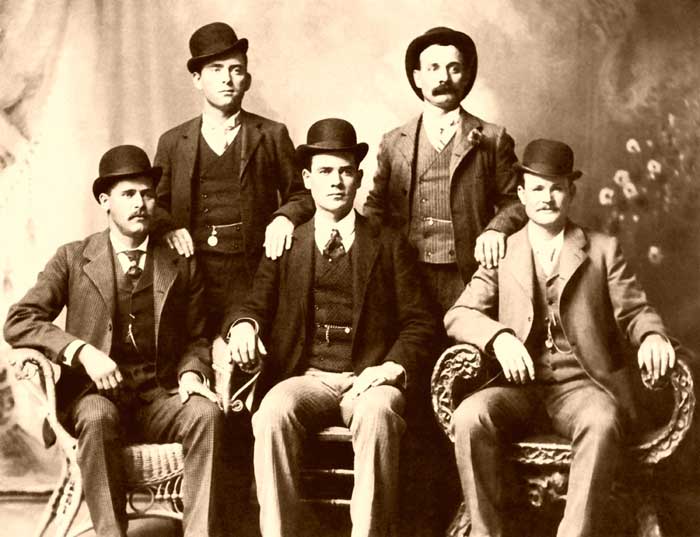
Wild Bunch, aka Hole in the Wall Gang (1896-1901) – Led by Butch Cassidy, the Wild Bunch terrorized the states of Colorado, Wyoming, Montana, Idaho, Utah, and Nevada for five years.
In December 1900, Cassidy posed alongside Longabaugh, Harvey Logan, Will Carver, and Ben Kilpatrick in Fort Worth, Texas, for the now-famous “Fort Worth Five” photograph. The Pinkerton Detective Agency obtained a copy of the photograph and began to use it for wanted posters.
William Carver and Ben Kilpatrick remained in Texas, and on April 1, 1901, Carver was ambushed by Sheriff Elijah Briant and his deputies at Sonora. William was shot by Briant and died from his wounds three hours later.
On July 3, 1901, Harvey “Kid Curry” Logan and a group of men robbed a Great Northern train near Wagner, Montana. This time, they took over $60,000 in cash (equivalent to $1,730,000 in 2016).
On November 8, 1901, Ben Kilpatrick and his girlfriend, Laura Bullion, were captured in St. Louis, Missouri. Kilpatrick was found guilty of robbery and sentenced to 15 years in prison, while Laura was sentenced to five. After serving 3 ½ years, Laura was released from the Missouri State Penitentiary, but she would never see her lover again.
Harvey Logan then headed to Tennessee, where in October, his girlfriend, Annie Rogers, had been arrested in Nashville for passing notes from the Montana robbery. On December 13, 1901, Harvey Logan killed two Knoxville policemen, William Dinwiddle and Robert Saylor, when they tried to apprehend him. Harvey’s girlfriend, Annie Rogers, spent time in jail until she was acquitted on June 18, 1902.
In a pool hall on November 30, 1902, Logan was captured after a lengthy physical fight with lawmen. He was convicted of robbery because the facts of the murder of the two policemen were not definite, and no witnesses would testify, and he received a sentence of 20 years of hard labor and a $5,000 fine. On June 27, 1903, Logan escaped. Rumors that a deputy had received an $8,000 bribe to allow his escape spread, but this was never proven.
A year later, he participated in robbing the Denver & Rio Grande train near Parachute, Colorado, on June 7, 1904. Two days later, a posse caught up with the outlaws, and in the confrontation, Logan was wounded. However, rather than go to prison, he took his own life. He was 37 years old when he died on June 9, 1904.
In the meantime, with the gang breaking up and feeling continuous pressure from the numerous law enforcement agencies pursuing them, Butch Cassidy and Harry Longabaugh fled to New York City. On February 20, 1901, along with Etta Place, Longabaugh’s female companion, they departed for Buenos Aires, Argentina, aboard the British steamer Herminius. Cassidy posed as James Ryan, Place’s fictitious brother. After their arrival, they settled in a four-room log cabin on a 15,000-acre ranch they purchased on the east bank of the Rio Blanco near Cholila, just east of the Andes in the Argentine province of Chubut.
On February 14, 1905, two English-speaking bandits, who may have been Cassidy and Longabaugh, held up the Banco de Tarapacá y Argentino in Río Gallegos, 700 miles south of Cholila. They then escaped north across the Patagonian steppes.
On May 1, fearing that law enforcement had located them, the trio sold the Cholila ranch and traveled north to San Carlos de Bariloche, where they embarked on the steamer Condor across Nahuel Huapí Lake and into Chile. By the end of the year, however, they had returned to Argentina. On December 19, 1905, Cassidy, Longabaugh, Place, and an unknown male associate robbed the Banco de la Nación branch in Villa Mercedes, 400 miles west of Buenos Aires, taking 12,000 pesos. Pursued by armed lawmen, they crossed the Pampas and the Andes to reach the safety of Chile.
On June 30, 1906, Etta Place decided that she had had enough of life on the run and was escorted back to San Francisco, California, by Longabaugh. Under the alias James “Santiago” Maxwell, Cassidy obtained work at the Concordia Tin Mine in the Santa Vera Cruz range of the central Bolivian Andes, where Longabaugh joined him upon his return. Their primary duties included guarding the company payroll. Still wanting to settle down as a respectable rancher, in late 1907, Cassidy traveled with Longabaugh to Santa Cruz, a frontier town in Bolivia’s eastern savannah.
The facts surrounding Butch Cassidy’s death are uncertain. On November 3, 1908, near San Vicente in southern Bolivia, a courier for the Aramayo Franke and Cia Silver Mine was conveying his company’s payroll, worth about 15,000 Bolivian pesos, by mule when he was attacked and robbed by two masked American bandits believed to be Cassidy and Longabaugh. The bandits then proceeded to the small mining town of San Vicente, where they lodged in a small boarding house owned by a resident miner named Bonifacio Casasola.
Casasola became suspicious of his two foreign lodgers. They had a mule from the Aramayo Mine, identifiable from the mine company brand on the mule’s left flank. Casasola left his house and notified a nearby telegraph officer, who notified a small Bolivian Army cavalry unit stationed nearby, the Abaroa Regiment. The unit dispatched three soldiers, under the command of Captain Justo Concha, to San Vicente, where they notified the local authorities. On the evening of November 6, the lodging house was surrounded by the soldiers, the police chief, the local mayor, and some of his officials, who intended to arrest the Aramayo robbers.
When the soldiers approached the house, the bandits opened fire, killing one of the soldiers and wounding another. A gunfight then ensued. At around 2 a.m., during a lull in the firing, the police and soldiers heard a man screaming from inside the house. Soon, a single shot was heard from inside the house, after which the screaming stopped. Minutes later, another shot was heard.
The standoff continued as locals kept the place surrounded until the next morning when, cautiously entering, the authorities found two dead bodies with numerous bullet wounds to the arms and legs. One of the men had a bullet wound in the forehead, and the other had a bullet hole in the temple. The local police report speculated that judging from the positions of the bodies, one bandit had probably shot his fatally wounded partner to put him out of his misery just before killing himself with his final bullet. In the subsequent investigation by the Tupiza police, the bandits were identified as the men who robbed the Aramayo payroll transport. Still, the Bolivian authorities didn’t know their real names, nor could they positively identify them.
The bodies were buried at the small San Vicente cemetery, where they were buried close to the grave of a German miner named Gustav Zimmer. Although attempts have been made to find their unmarked grave, no remains with DNA matching the living relatives of Cassidy and Longabaugh have yet been discovered.
Through the years, there have been claims that the pair killed in Bolivia was not Cassidy and Longabaugh. One story alleged by Josie Bassett claimed that Cassidy had come to visit her in the 1920s “after returning from South America” and that he didn’t die until about 1940. Another claim was made by a doctor named Francis Smith, who claimed that he had treated Cassidy and told him that a surgeon in Paris had altered his face and that he showed Smith a repaired bullet wound that Smith recognized as work he had previously done on him.
Locals of Cassidy’s hometown of Circleville, Utah, claimed that he had worked in Nevada until his death. Notably, Cassidy’s sister, Lula Park Betenson, stated that her brother had returned to the family home in Circleville. In another town — Baggs, Wyoming, a popular destination of the Wild Bunch during their raiding years, others claimed that Cassidy had visited in the 1920s.
Cassidy’s sister would also report that Butch lived out his years in “the Northwest” and died in 1937 and that the family had agreed not to disclose his final resting place since “they had chased him all his life, and now he’s going to rest in peace.”
Despite his criminal background, by all accounts, Cassidy was a charming, well-liked thief who never, it is believed, killed anyone. Cassidy also had a reputation for keeping his word. As one story goes, Cassidy asked to be released the night before he began his sentence, promising he’d return to jail the following day. Authorities took him at his word and let him go, and Cassidy returned to them the following morning.
Parker’s life and death have been extensively dramatized in film, television, and literature, and he remains one of the most well-known icons of the “Wild West.”
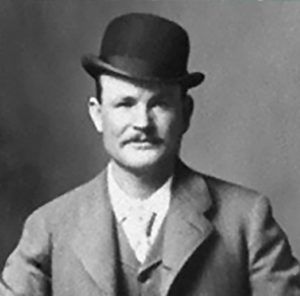
Butch Cassidy
© Kathy Alexander/Legends of America, updated November 2022.
Also See:
Old West People Photo Galleries
Sources:

